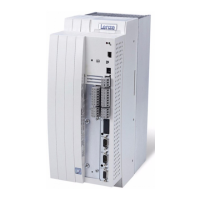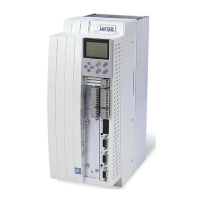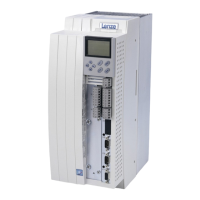Configuration
Function blocks
Diameter calculator (DCALC)
8
8.2
8.2.1
8.2−4
EDSVF9383V EN 7.1−04/2012
In configurations with a speed forward control it is common to multiply the
precontrol signal with the reciprocal value of the diameter (d). This value is
output at DCALC1−OUT.
ƒ C1308 = 0: DCALC1−OUT = d
ƒ C1308 = 1: DCALC1−OUT = 1/d
For the conversion to 1/d the reference value for the diameter has to be
defined in C1309, for which the signal at DCALC1−OUT is to be 100 %.
ƒ Normally C1309 corresponds to the minimum diameter in C1305
(d
min
).
In order to ensure a continuous transition when setting new diameter
values, a ramp function generator is activated if C1310 > 0 s.
A window comparator compares the corresponding newly calculated value
to the value last filtered.
ƒ In C1311 the maximum difference in [%] between the two values is
defined.
ƒ DCALC1−I=0 is set to LOW if the maximum difference is exceeded.
Current diameter (C1328)
C1328 [mm] +
DCALC1−N−LINE [inc]
DCALC1−N−WIND [inc]
@
C1300 [rpm]
C1301 [rpm]
@ C1304 [mm]
Output signal at DCALC1−OUT
For C1308 = 0 (DCALC1−OUT = d):
DCALC1−OUT [%] +
C1328 [mm]
C1304 [mm]
@ 100 %
For C1308 = 1 (DCALC1−OUT = 1/d):
DCALC1−OUT [%] +
C1304 [mm]
C1328 [mm]
@
C1309 [mm]
C1304 [mm]
@ 100 %
Note!
The value at DCALC1−OUT is limited by the maximum reel
diameter (C1306) and the minimum reel diameter (C1305).
Converting the diameter (d)
to 1/d
Web break monitoring
Formulas for calculation

